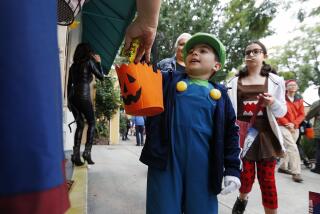Keeping Halloween Dangers Imaginary : Safety: The very real risk of accidents during trick-or-treating can be minimized with a few simple precautions by parents and candy-givers.
As darkness falls on neighborhoods Sunday night, little ghouls, goblins and witches will appear from the shadows in search of Halloween treats.
In that darkness lurks danger. But most of it can be avoided by taking a few precautions.
The Orange County Fire Department has some suggestions:
Costumes should be short enough to prevent children from tripping and falling, and lightly-colored or bright enough to be easily visible to motorists. Also, costumes should be decorated or trimmed with reflective tape that glows in the beam of a carâs headlights. Bags or sacks should also be light-colored and decorated with reflective tape.
Smaller children should be accompanied by an adult or an older, responsible child. And at least one person in every group should carry a flashlight.
Tell children to walk, not run, from house to house to avoid being hurt by hard-to-see objects in yards and lawns.
Children should be cautioned to knock only on doors of homes where residents have outside lights on as a sign of welcome. And they shouldnât enter homes or apartments unless they are accompanied by an adult.
When buying a costume, look for masks, beards and wigs that are made of fire-resistant material.
If youâre making a costume, remember that tightly woven, heavy and smooth fabrics are more flame-resistant. Flimsy materials and outfits with baggy sleeves or billowing shirts should be avoided if there is any risk of contacting fire sources.
Masks should be loose-fitting, with eyeholes large enough to allow unobstructed vision.
Accessories such as swords, knives, wands or similar items that are carried should be made of soft or flexible material.
Children should not eat any of their treats before they have them inspected when they get home.
Residents receiving trick-or-treaters at their doors should remove anything on the steps, lawns and porches that could be an obstacle to children.
Jack-o-lanterns should be kept away from landings and doorsteps where there is a possibility that costumes could brush against flames.
Indoor jack-o-lanterns should never be placed near curtains, decorations or other furnishings. A safe alternative is to put a small flashlight inside the carved pumpkin.
Halloween presents a whole set of different concerns for parents of children with diabetes.
âChildren look forward all year to dressing up on Halloween and trick-or-treating for all those goodies with their friends,â said Dr. Gloria Martinez of Kaiser Permanente Hospital-Orange County. âBut to small children with dietary restrictions, Halloween can be a painful reminder of their limitations and they may feel socially isolated.â
Martinez suggests:
* Allowing a child to trick-or-treat, then âbuyingâ the candy back with another, healthy treat or a non-edible item the child desires.
* Organizing or attending a Halloween event that focuses on games and fun activities rather than on candy.
* In consultation with a doctor, allowing the child to indulge for the evening. This will require planning ahead and giving the child extra insulin to balance out the increase in blood sugar that will result from eating sweets.
More to Read
Sign up for Essential California
The most important California stories and recommendations in your inbox every morning.
You may occasionally receive promotional content from the Los Angeles Times.








